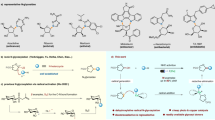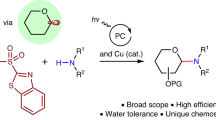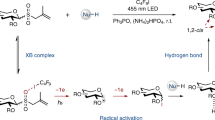Abstract
Stereochemically defined C-glycosides are prized for their biological activity. Developing a catalytic method that comprises non-precious metals to synthesize these C-glycosides remains challenging. Here, starting from readily accessible glycosyl chlorides, we show that an Earth-abundant iron-based catalyst promotes the facile generation of glycosyl radicals, which either react directly with an unsaturated electrophile or are captured by an organonickel species to facilitate C−C bond formation under mild reductive conditions. Exploration of these two reaction pathways across a range of substrates has produced a diverse array of C-glycoside products functionalized with alkenyl, alkynyl or aromatic anomeric groups, with excellent diastereocontrol. Mechanistic control and electron paramagnetic resonance spectroscopic experiments indicate that the active catalytic species is a low-valent iron complex formed through Mn reduction. The method was applied in the stereoselective synthesis of bioactive C-glycosides and therapeutically relevant analogues.

This is a preview of subscription content, access via your institution
Access options
Subscribe to this journal
Receive 12 digital issues and online access to articles
$119.00 per year
only $9.92 per issue
Buy this article
- Purchase on Springer Link
- Instant access to full article PDF
Prices may be subject to local taxes which are calculated during checkout





Similar content being viewed by others
Data availability
All data supporting the findings of this study are available within the Article and its Supplementary Information. Crystallographic data for the structure (6f) reported in this Article have been deposited at the Cambridge Crystallographic Data Centre, under deposition number CCDC 2056391. Copies of the data can be obtained free of charge via https://www.ccdc.cam.ac.uk/structures/.
References
Han, F.-S. Transition-metal-catalyzed Suzuki–Miyaura cross-coupling reactions: a remarkable advance from palladium to nickel catalysts. Chem. Soc. Rev. 42, 5270–5298 (2013).
Biffis, A., Centomo, P., Del Zotto, A. & Zecca, M. Pd metal catalysts for cross-couplings and related reactions in the 21st century: a critical review. Chem. Rev. 118, 2249–2295 (2018).
Magano, J. & Dunetz, J. R. Large-scale applications of transition metal-catalyzed couplings for the synthesis of pharmaceuticals. Chem. Rev. 111, 2177–2250 (2011).
Nicolaou, K. C., Bulger, P. G. & Sarlah, D. Palladium-catalyzed cross-coupling reactions in total synthesis. Angew. Chem. Int. Ed. 44, 4442–4489 (2005).
Corbet, J. P. & Mignani, G. Selected patented cross-coupling reaction technologies. Chem. Rev. 106, 2651–2710 (2006).
Buono, F., Nguyen, T., Qu, B., Wu, H. & Haddad, N. Recent advances in nonprecious metal catalysis. Org. Process Res. Dev. 25, 1471–1495 (2021).
Fürstner, A., Leitner, A., Méndez, M. & Krause, H. Iron-catalyzed cross-coupling reactions. J. Am. Chem. Soc. 124, 13856–13863 (2002).
Campeau, L. C. & Hazari, N. Cross-coupling and related reactions: connecting past success to the development of new reactions for the future. Organometallics 38, 3–35 (2019).
Tasker, S. Z., Standley, E. A. & Jamison, T. F. Recent advances in homogeneous nickel catalysis. Nature 509, 299–309 (2014).
Holland, P. L. Reaction: opportunities for sustainable catalysts. Chem 2, 443–447 (2017).
Bauer, I. & Knölker, H.-J. Iron catalysis in organic synthesis. Chem. Rev. 115, 3170–3387 (2015).
Fürstner, A. Iron catalysis in organic synthesis: a critical assessment of what it takes to make this base metal a multitasking champion. ACS Cent. Sci. 2, 778–789 (2016).
Rana, S., Biswas, J. P., Paul, S., Paik, A. & Maiti, D. Organic synthesis with the most abundant transition metal—iron: from rust to multitasking catalysts. Chem. Soc. Rev. 50, 243–472 (2021).
Piontek, A., Bisz, E. & Szostak, M. Iron-catalyzed cross-couplings in the synthesis of pharmaceuticals: in pursuit of sustainability. Angew. Chem. Int. Ed. 57, 11116–11128 (2018).
Mako, T. L. & Byers, J. A. Recent advances in iron-catalysed cross coupling reactions and their mechanistic underpinning. Inorg. Chem. Front. 3, 766–790 (2016).
Zweig, J. E., Kim, D. E. & Newhouse, T. R. Methods utilizing first-row transition metals in natural product total synthesis. Chem. Rev. 117, 11680–11752 (2017).
Neidig, M. L. et al. Development and evolution of mechanistic understanding in iron-catalyzed cross-coupling. Acc. Chem. Res. 52, 140–150 (2019).
Sears, J. D., Neate, P. G. N. & Neidig, M. L. Intermediates and mechanism in iron-catalyzed cross-coupling. J. Am. Chem. Soc. 140, 11872–11883 (2018).
Ye, Y., Chen, H.-F., Yao, K. & Gong, H.-G. Iron-catalyzed reductive vinylation of tertiary alkyl oxalates with activated vinyl halides. Org. Lett. 22, 2070–2075 (2020).
Everson, D. A. & Weix, D. J. Cross-electrophile coupling: principles of reactivity and selectivity. J. Org. Chem. 79, 4793–4798 (2014).
Beau, J.-M. & Gallagher, T. in Glycoscience Synthesis of Substrate Analogs and Mimetics (eds Driguez, H. & Thiem, J.) 1−54 (Springer, 1998).
Nicotra, F. Synthesis of C-glycosides of biological interest. Top. Curr. Chem. 187, 55–83 (1997).
Yuan, X. J. & Linhardt, R. J. Recent advances in stereoselective C-glycoside synthesis. Tetrahedron 54, 9912–9959 (1998).
Postema, M. H. D. Recent developments in the synthesis of C-glycosides. Tetrahedron 48, 8545–8599 (1992).
Adak, L. et al. Synthesis of aryl C‑glycosides via iron-catalyzed cross coupling of halosugars: stereoselective anomeric arylation of glycosyl radicals. J. Am. Chem. Soc. 139, 10693–10701 (2017).
Lo, J.-C., Gui, J., Yabe, Y., Pan, C. M. & Baran, P. S. Functionalized olefin cross-coupling to construct carbon–carbon bonds. Nature 516, 343–348 (2014).
Tardieu, D. et al. Stereoselective synthesis of C,C-glycosides from exo-glycals enabled by iron-mediated hydrogen atom transfer. Org. Lett. 18, 7262–7267 (2019).
Štambaský, J., Hocek, M. & Kočovský, P. C-nucleosides: synthetic strategies and biological applications. Chem. Rev. 109, 6729–6764 (2009).
Granier, T. & Vasella, A. Synthesis and evaluation as glycosidase inhibitors of 1H-imidazol-2-yl C-glycopyranosides. Helv. Chim. Acta 78, 1738–1746 (1995).
Temburnikar, K. & Seley-Radtke, K. L. Recent advances in synthetic approaches for medicinal chemistry of C-nucleosides. Beilstein J. Org. Chem. 14, 772–785 (2018).
Kitamura, K., Ando, Y., Matsumoto, T. & Suzuki, K. Total synthesis of aryl C-glycoside natural products: Strategies and tactics. Chem. Rev. 118, 1495–1598 (2018).
Yang, Y. & Yu, B. Recent advances in the chemical synthesis of C-glycosides. Chem. Rev. 117, 12281–12356 (2017).
Bokor, É. et al. C-glycopyranosyl arenes and hetarenes: synthetic methods and bioactivity focused on antidiabetic potential. Chem. Rev. 117, 1687–1764 (2017).
Guisán-Ceinos, M., Tato, F., Buñuel, E., Calle, P. & Cárdenas, D. J. Fe-catalysed Kumada-type alkyl–alkyl cross-coupling. Evidence for the intermediacy of Fe(I) complexes. Chem. Sci. 4, 1098–1104 (2013).
Adams, C. J. et al. Iron(I) in Negishi cross-coupling reactions. J. Am. Chem. Soc. 134, 10333–10336 (2012).
Hill, D. H., Parvez, M. A. & Sen, A. Mechanistic aspects of the reaction of anionic iron(0)–olefin complexes with organic halides. Detection and characterization of paramagnetic organometallic intermediates. J. Am. Chem. Soc. 116, 2889–2901 (1994).
Cheung, C.-W., Zhurkin, F. E. & Hu, X.-L. Z-Selective olefin synthesis via iron-catalyzed reductive coupling of alkyl halides with terminal arylalkynes. J. Am. Chem. Soc. 137, 4932–4935 (2015).
Fleischauer, V. E., Muñoz, S. B. III, Neate, P. G. N., Brennessel, W. W. & Neidig, M. M. NHC and nucleophile chelation effects on reactive iron(II) species in alkyl–alkyl cross-coupling. Chem. Sci. 9, 1878–1891 (2018).
Rummelt, S. M., Peterson, P. O., Zhong, H. Y. & Chirik, P. J. Oxidative addition of aryl and alkyl halides to a reduced iron pincer complex. J. Am. Chem. Soc. 143, 5928–5936 (2021).
Liu, J., Ye, Y., Sessler, J. L. & Gong, H. Cross-electrophile couplings of activated and sterically hindered halides and alcohol derivatives. Acc. Chem. Res. 53, 1833–1845 (2020).
Xu, L.-Y., Fan, N.-L. & Hu, X.-G. Recent development in the synthesis of C-glycosides involving glycosyl radicals. Org. Biomol. Chem. 18, 5095–5109 (2020).
Harris, J. D., Oelkers, A. B. & Tyler, D. R. The solvent cage effect: is there a spin barrier to recombination of transition metal radicals? J. Am. Chem. Soc. 129, 6255–6262 (2007).
Barry, J. T., Berg, D. J. & Tyler, D. R. Radical cage effects: the prediction of radical cage pair recombination efficiencies using microviscosity across a range of solvent types. J. Am. Chem. Soc. 139, 14399–14405 (2017).
Yu, X.-L., Zheng, H.-L., Zhao, H.-N., Lee, B. C. & Koh, M. J. Iron-catalyzed regioselective alkenylboration of olefins. Angew. Chem. Int. Ed. 60, 2104–2109 (2021).
Wei, Y.-L., Ben-Zvi, B. & Diao, T.-N. Diastereoselective synthesis of aryl C-glycosides from glycosyl esters via C–O bond homolysis. Angew. Chem. Int. Ed. 60, 9433–9438 (2021).
Liu, J.-D. & Gong, H. Stereoselective preparation of α‑C‑vinyl/aryl glycosides via nickel-catalyzed reductive coupling of glycosyl halides with vinyl and aryl halides. Org. Lett. 20, 7991–7995 (2018).
Dumoulin, A., Matsui, J. K., Gutiérrez-Bonet, Á. & Molander, G. A. Synthesis of non-classical arylated C-saccharides through nickel/photoredox dual catalysis. Angew. Chem. Int. Ed. 57, 6614–6618 (2018).
Mou, Z.-D., Wang, J.-X. & Niu, D. W. Stereoselective preparation of C-aryl glycosides via visible-light-induced nickel-catalyzed reductive cross-coupling of glycosyl chlorides and aryl bromides. Adv. Synth. Catal. 363, 3025–3029 (2021).
Kim, S., Goldfogel, M. J., Gilbert, M. M. & Weix, D. J. Nickel-catalyzed cross-electrophile coupling of aryl chlorides with primary alkyl chlorides. J. Am. Chem. Soc. 142, 9902–9907 (2020).
Olivares, A. M. & Weix, D. J. Multimetallic Ni- and Pd-catalyzed cross-electrophile coupling to form highly substituted 1,3-dienes. J. Am. Chem. Soc. 140, 2446–2449 (2018).
Huang, L., Ackerman, L. K. G., Kang, K., Parsons, A. M. & Weix, D. J. LiCl-accelerated multimetallic cross-coupling of aryl chlorides with aryl triflates. J. Am. Chem. Soc. 141, 10978–10983 (2019).
Kang, K., Huang, L. & Weix, D. J. Sulfonate versus sulfonate: nickel and palladium multimetallic cross-electrophile coupling of aryl triflates with aryl tosylates. J. Am. Chem. Soc. 142, 10634–10640 (2020).
Li, M. et al. Visible-light-induced Pd-catalyzed radical strategy for constructing C-vinyl glycosides. Org. Lett. 22, 6288–6293 (2020).
Ghosh, S. & Pradhan, T. K. Stereoselective total synthesis of (+)-varitriol, (–)-varitriol, 5′-epi-(+)-varitriol, and 4′-epi-(–)-varitriol from d-mannitol. J. Org. Chem. 75, 2107–2110 (2010).
Sánchez-Eleuterio, A., García-Santos, W. H., Díaz-Salazar, H., Hernández-Rodríguez, M. & Cordero-Vargas, A. Stereocontrolled nucleophilic addition to five-membered oxocarbenium ions directed by the protecting groups. Application to the total synthesis of (+)-varitriol and of two diastereoisomers thereof. J. Org. Chem. 82, 8464–8475 (2017).
Koh, M. J., Nguyen, T. T., Zhang, H.-M., Schrock, R. R. & Hoveyda, A. H. Direct synthesis of Z-alkenyl halides through catalytic cross-metathesis. Nature 531, 459–465 (2016).
Gillis, E. P., Eastman, K. J., Hill, M. D., Donnelly, D. J. & Meanwell, N. A. Applications of fluorine in medicinal chemistry. J. Med. Chem. 58, 8315–8359 (2015).
Wang, Q. Q. et al. Palladium-catalysed C–H glycosylation for synthesis of C-aryl glycosides. Nat. Catal. 2, 793–800 (2019).
Düfert, M. A., Billingsley, K. L. & Buchwald, S. L. Suzuki–Miyaura cross-coupling of unprotected, nitrogen-rich heterocycles: substrate scope and mechanistic investigation. J. Am. Chem. Soc. 135, 12877–12885 (2013).
Zhu, M.-X. & Messaoudi, S. Diastereoselective decarboxylative alkynylation of anomeric carboxylic acids using Cu/photoredox dual catalysis. ACS Catal. 11, 6334–6342 (2021).
Kusunuru, A. K., Tatina, M., Yousuf, S. K. & Mukherjee, D. Copper mediated stereoselective synthesis of C-glycosides from unactivated alkynes. Commun. Chem. 49, 10154–10156 (2013).
Wilkinson, B. L., Bornaghi, L. F., Poulsen, S.-A. & Houston, T. A. Synthetic utility of glycosyl triazoles in carbohydrate chemistry. Tetrahedron. 62, 8115–8125 (2006).
Hatakeyama, T., Hashimoto, S., Ishizuka, K. & Nakamura, M. Highly selective biaryl cross-coupling reactions between aryl halides and aryl Grignard reagents: a new catalyst combination of N-heterocyclic carbenes and iron, cobalt, and nickel fluorides. J. Am. Chem. Soc. 131, 11949–11963 (2009).
Prier, C. K. & MacMillan, D. W. Amine α-heteroarylation via photoredox catalysis: a homolytic aromatic substitution pathway. Chem. Sci. 5, 4173–4178 (2014).
Masuda, K., Nagatomo, M. & Inoue, M. Direct assembly of multiply oxygenated carbon chains by decarbonylative radical–radical coupling reactions. Nat. Chem. 9, 207–212 (2016).
Igarashi, K. The Koenigs–Knorr reaction. Adv. Carbohydr. Chem. Biochem. 34, 243–283 (1977).
Li, M. et al. Transition-metal-free chemo- and regioselective vinylation of azaallyls. Nat. Chem. 9, 997–1004 (2017).
Yu, Y., Smith, J. M., Flaschenriem, C. J. & Holland, P. L. Binding affinity of alkynes and alkenes to low-coordinate iron. Inorg. Chem. 45, 5742–5751 (2006).
Weidauer, M., Irran, E., Someya, C. I., Haberberger, M. & Enthaler, S. Nickel-catalyzed hydrodehalogenation of aryl halides. J. Organomet. Chem. 729, 53–59 (2013).
Manzoor, A., Wienefeld, P., Baird, M. C. & Budzelaar, P. H. M. Catalysis of cross-coupling and homocoupling reactions of aryl halides utilizing Ni(0), Ni(I), and Ni(II) precursors; Ni(0) compounds as the probable catalytic species but Ni(I) compounds as intermediates and products. Organometallics 36, 3508–3519 (2017).
Zhu, F. & Walczak, M. A. Stereochemistry of transition metal complexes controlled by the metallo-anomeric effect. J. Am. Chem. Soc. 142, 15127–15136 (2020).
Dugave, C. & Demange, L. cis−trans isomerization of organic molecules and biomolecules: implications and applications. Chem. Rev. 103, 2475–2532 (2003).
Gaspari, R., Prota, A. E., Bargsten, K., Cavalli, A. & Steinmetz, M. O. Structural basis of cis- and trans-combretastatin binding to tubulin. Chem 2, 102–113 (2017).
Lu, X. et al. Nickel-catalyzed defluorinative reductive cross-coupling of gem-difluoroalkenes with unactivated secondary and tertiary alkyl halides. J. Am. Chem. Soc. 139, 12632–12637 (2017).
Pu, L. & Yu, H.-B. Catalytic asymmetric organozinc additions to carbonyl compounds. Chem. Rev. 101, 757–824 (2001).
Wang, G.-Y. et al. Synthesis and anti-influenza activity of pyridine, pyridazine, and pyrimidine C-nucleosides as favipiravir (T-705) analogues. J. Med. Chem. 59, 4611–4624 (2016).
Koester, D. C., Kriemen, E. & Werz, D. B. Flexible synthesis of 2-deoxy-C-glycosides and (1→2)-, (1→3)-, and (1→4)-linked C-glycosides. Angew. Chem. Int. Ed. 52, 2985–2989 (2013).
Enthaler, S., Junge, K. & Beller, M. Sustainable metal catalysis with iron: from rust to a rising star? Angew. Chem. Int. Ed. 47, 3317–3321 (2008).
Acknowledgements
This research was supported by the Research Scholarship Block from the Ministry of Education, Singapore: C-143-000-207-532, C-141-000-777-532 and C-141-000-333-532 (M.J.K.), and NSFC-21725204 (G.C.). We thank G. K. Tan (National University of Singapore) for X-ray crystallographic analysis. We thank X.-X. Wang and X. Lu (University of Science and Technology of China) for assistance in preparing samples for the electron paramagnetic resonance experiments.
Author information
Authors and Affiliations
Contributions
Q.W., Q.S., Y.J. and H.Z. developed the catalytic method. L.Y. and C.T. carried out the electron paramagnetic resonance experiments. M.J.K. and G.C. directed the investigations. M.J.K. wrote the manuscript with revisions provided by the other authors.
Corresponding authors
Ethics declarations
Competing interests
The authors declare no competing interests.
Peer review
Peer review information
Nature Synthesis thanks the anonymous reviewers for their contribution to the peer review of this work. Thomas West was the primary editor on this article and managed its editorial process and peer review in collaboration with the rest of the editorial team.
Additional information
Publisher’s note Springer Nature remains neutral with regard to jurisdictional claims in published maps and institutional affiliations.
Supplementary information
Supplementary Information
Supplementary Tables 1–16, Figs. 1–28, experimental data, synthesis and characterization data, NMR spectra, X-ray crystallographic data and references.
Supplementary Data 1
Crystallographic data for compound 6f.
Rights and permissions
About this article
Cite this article
Wang, Q., Sun, Q., Jiang, Y. et al. Iron-catalysed reductive cross-coupling of glycosyl radicals for the stereoselective synthesis of C-glycosides. Nat Synth 1, 235–244 (2022). https://doi.org/10.1038/s44160-022-00024-5
Received:
Accepted:
Published:
Issue Date:
DOI: https://doi.org/10.1038/s44160-022-00024-5
This article is cited by
-
N-glycoside synthesis through combined copper- and photoredox-catalysed N-glycosylation of N-nucleophiles
Nature Synthesis (2024)
-
Dehydroxylative radical N-glycosylation of heterocycles with 1-hydroxycarbohydrates enabled by copper metallaphotoredox catalysis
Nature Communications (2024)
-
Direct synthesis of unprotected aryl C-glycosides by photoredox Ni-catalysed cross-coupling
Nature Synthesis (2023)
-
Visible light activation enables desulfonylative cross-coupling of glycosyl sulfones
Nature Synthesis (2022)
-
Iron-mediated ligand-to-metal charge transfer enables 1,2-diazidation of alkenes
Nature Communications (2022)



